How’re your Apps and Them?
I was on a panel last night at Hofstra University talking to Masters level students about technology, PR and marketing and a mobile question came up. “Is it better to build a mobile app or use responsive design on your website and send the mobile traffic there?” The answer lies in what the marketer is trying to do or sell – an app is not a website – but this got me thinking about apps. And here’s where I net out. Apps are downloadable tools easily accessed on smarties. But do they need to be downloaded at all?
One of the panelists got lost while parking on the Hofstra campus and suggested it would have been nice to have had an app that led him to McEwen Hall. Frankly, that app could be sold to any school. But why an app? Why not go to Hofstra, click directions and click a “guide me in” button?
I just think the functionality of all of these apps will eventually be in the cloud and accessible in real time. Why load up our endpoint devices? Is it a wireless bandwidth issue? A security issue? A developer remuneration issue?
Just as we are coming around to not having to distinguish between marketing and digital marketing, I think the proliferation of apps as downloadables will wane and we’ll just have web-based functionality. What do you think?
Peace. And thanks Hilary Topper for allowing me into your class.



